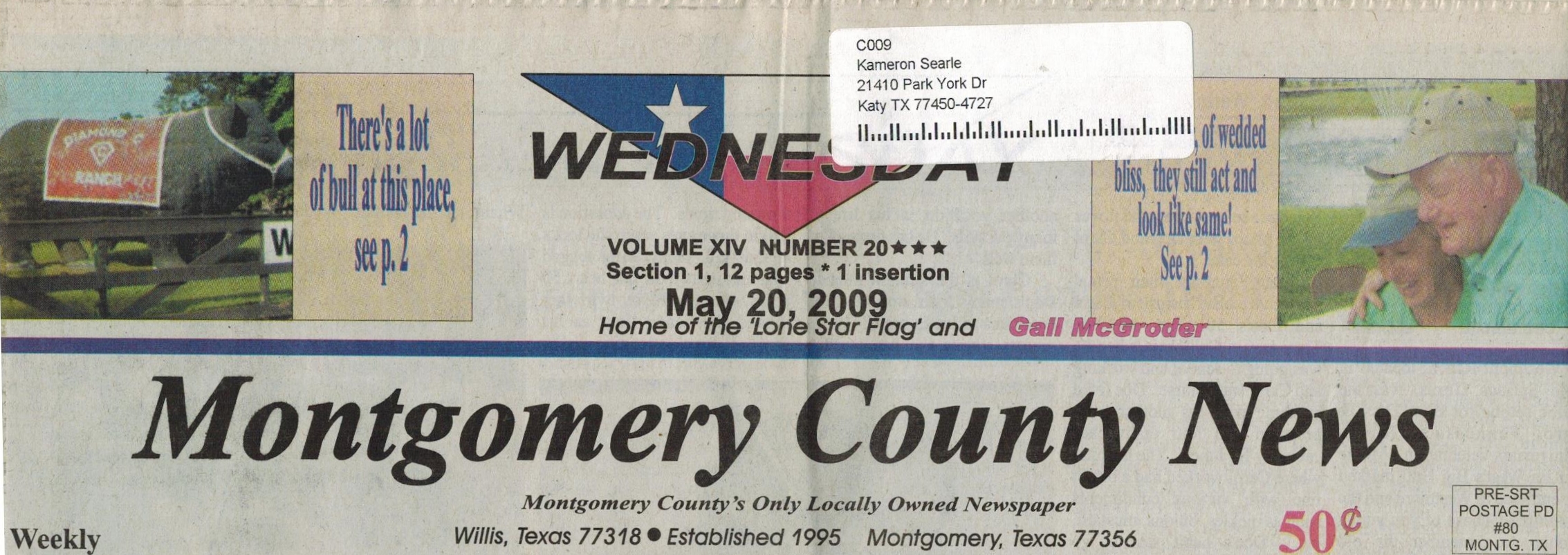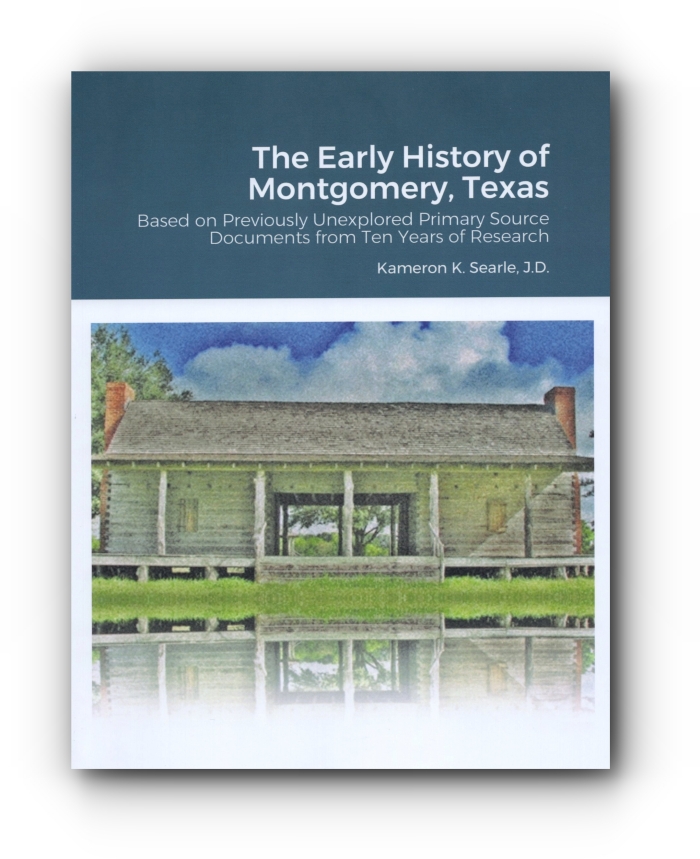Letter to the Editor – Part 2
When Does Family Tradition Become Family Fiction?
"Montgomery Family Tradition"
Wednesday, June 3, 2009 Edition
Montgomery County News

‘It is a capital mistake to theorize before one has data.
Insensibly one begins to twist facts to suit theories,
instead of theories to suit facts.’
Sherlock Holmes
A Scandal in Bohemia
In one of my articles, I
had mentioned that William Harley Gandy had interviewed J. L. Montgomery of Richards, Texas while writing his
master’s thesis in 1952. I had questioned the fact that Robin Montgomery’s grandfather J. L. Montgomery made
no mention of an Andrew Montgomery trading post in his interview with Gandy. In this 1952 interview, J. L.
Montgomery had advised William Harley Gandy that Montgomery County was named after a surveyor named William
Montgomery.
In his 1952 master’s
thesis, Gandy wrote, “Another local story has it that Montgomery took its name from William Montgomery, a
surveyor and widower, who came to Texas in 1822 with his sons…. In 1830, he settled some seven miles southwest
of the town of Montgomery in what is present day Grimes County…. It is claimed by the descendants of these two
brothers [John and Andrew] that the county was named for the surveyor William Montgomery.”
In 1975, after 152 years of silence, from the alleged date it was founded, the Andrew
Montgomery Trading post sprang forth in Robin Montgomery’s book, The
History of Montgomery County (Austin: Jenkins Publishing Co., 1975) complete in every detail for the very
first time anywhere.
On page 285 of The History of Montgomery County, Robin Montgomery wrote, “This
book has shown that the reason the town and county came to be named for Andrew Montgomery lies in the events
surrounding his trading post.” Robin goes on to write, “Andrew
immediately set about encouraging settlers to venture down these roads to become his neighbors and clientele.
In this manner Andrew’s Trading Post became the major pivot point around which the settlement of the later
Montgomery County region revolved. Andrew’s last name became a unifying element among the gradually expanding
circle of settlement.”
In my article, I had asked why
J. L. Montgomery, nor any other member of the William Montgomery family, had ever made any mention of this
Andrew Montgomery Trading Post before 1975. If the trading post was established in 1823, how is it that no
one ever mentioned it for 152 years until 1975?
In his May 20, 2009 letter to the
editor, Robin attempts to address this question and provides a most extraordinary answer with ramifications that
would seem to completely undo Robin’s history of the Andrew Montgomery Trading Post. I do not believe I could
have written a more critical or damaging statement regarding this portion of Robin’s history than he himself has
written.
My contention is that a couple of Robin's comments in his letter to the editor
completely undo his history of the Andrew Montgomery Trading Post and reveal it for what it is: family
fiction rather than family tradition. Robin's grandfather, J. L. Montgomery, clearly knew nothing about
an Andrew Montgomery Trading Post when Gandy interviewed him in 1952. It is Robin's response to this
point in his letter to the editor that wreck's his history.
Please read this very carefully. In his May 20, 2009 letter to the editor, Robin
wrote:
“…the William-Andrew Montgomery descendants did
not know of the Shannon tradition until the Historicade in Conroe in 1949. When actors in that ceremony stated
that the town was begun by a Montgomery Trading Post operated by the Shannon’s, as a child I heard the elder
members of my family exclaim, “They have forgotten William and Andrew!””
“Hence the family pieced together the logical
sequence that, if Shannon tradition ran true, the Shannon’s assumed a facsimile of the business which Andrew, by
then into surveying, had pioneered years earlier, and given that Owen Shannon’s wife’s maiden name was
Montgomery, continued the name.”
“Also during the early fifties, from an elderly
relative the family received a book of notes since referred to as the Crittendon papers. It included an excerpt from the family Bible reinforcing oral tradition:
“Andrew rode with Dr. Long [Long Expedition 1819-1820] Started Montgomery Settlement.” Accordingly, during this
period of reassessment the Montgomery family began to consider Andrew rather than the patriarch, William as the
probable basis for the naming of the town.”
Fascinating! J. L. Montgomery had the opportunity to set the record straight in his
interview with William Harley Gandy in 1952. But, as upset as
the Montgomery Family allegedly was following the 1949 Historicade, J. L. Montgomery made no mention to Gandy
of any trading post operated by the Montgomery family in the 1820’s.
Robin then admits
that the Montgomery “family pieced together the logical sequence that if Shannon tradition was true, the
Shannon’s assumed a facsimile of the business which Andrew…had pioneered years earlier…” Robin amazingly admits the Montgomery family incorporated the Shannon
family tradition of a Montgomery Trading Post directly into the Montgomery family tradition.
No fact checking
was done. It just says, “that, if Shannon tradition ran true.” Whether it was true or not, Robin informs
us that the Montgomery family incorporated the Shannon tradition into their own family tradition.
Though unchecked, the Shannon's Montgomery Trading Post story was obviously a very popular idea, so the
Montgomerys just included it into their story.
Robin then mentions an excerpt from “the family Bible.” He wrote that the Crittendon
papers “included an excerpt from the family Bible reinforcing oral tradition: “Andrew rode with Dr. Long
[Long Expedition 1819-1820] Started Montgomery Settlement.””
We are left with a great many questions about this “excerpt from the family Bible” and
the Crittendon papers. Why is this excerpt not mentioned in Robin’s 1975 book or any book or article written
by Robin since 1975. Why is this excerpt coming to light for the
first time in May of 2009. Whose family bible was this? Who
wrote the note? Whose handwriting is the note in? What is the
provenance of this family Bible? Why has no one been allowed to
see this excerpt or the Crittendon papers since 1975? Is there anything about the excerpt that tells us where
the “Montgomery Settlement” was supposed to have been? Will Robin Montgomery allow us to see the Crittendon
papers or this excerpt in order to judge their historical value?
Then Robin writes the most extraordinary statement of all:
“Accordingly, during this period of reassessment the Montgomery family began to
consider Andrew rather than the patriarch, William as the probable basis for the naming of the
town.”
The Montgomery family
changed their story altogether “during this period of reassessment” in the 1950’s! “During this period of reassessment,” they reject J. L. Montgomery’s family
history that says the surveyor William Montgomery is the source of the name of the county and they “began to
consider Andrew…as the probable basis for the naming of the town.”
Not only did the Montgomery family change the story, but they also guessed!
After about 125 years, the
Montgomery family threw out the family tradition of William Montgomery as the source of the county's name after
watching a play in 1949 and receiving the mysterious and unproven "Crittendon papers." The
Montgomery family arbitrarily changed, in the 1950's, what had allegedly been handed down in the
Montgomery family from one generation to the next for 125 years.
Up until 1952, the
Montgomery family tradition, of which we have a snap shot from Gandy’s thesis, was that the source of the name
of the county was the surveyor William Montgomery, not a trading post. After 1952, the Montgomery family rejects
their family tradition received from Robin’s grandfather, J. L. Montgomery. They incorporate much of the Shannon family tradition regarding a so-called
Montgomery Trading Post that was not present in the 1952 interview, and then they guess that Andrew must have
been the probable basis of the naming of the town.
Wow! Knowing now what Robin has told us, is anybody still on board with the Andrew
Montgomery Trading Post at this point?
It is not what someone else or I have written or speculated. This is clearly what
Robin Montgomery has written himself. Robin’s quote is out there for all to consider and critique
forever. As I stated earlier, I believe Robin has completely undone the main historical premise of
his entire book. The Montgomery family can't just decide to
completely rework their family tradition into something brand new during the 1950's and then insist that it
is a valid historical source or oral family tradition dating from the 1820's.
It has been difficult for historians to respond to Robin’s history of an Andrew
Montgomery Trading Post as he makes so many dogmatic assertions rather than reasonable and defensible
arguments.
Famed historian, David Hackett Fischer, made it very clear in his classic book
Historians' Fallacies that "the burden of proof, for any historical assertion, always rests upon its
author." See Historians' Fallacies: Toward
a Logic of Historical Thought (New York: HarperCollins, 1970), pp. 62 and 63. Robin cites no primary sources of evidence in
his 1975 book for his history of an Andrew Montgomery Trading Post. Only now does he tell us fragments
of alleged evidence which he has not previously cited or shown to anyone before.
Robin violates two more of David Hackett Fischer's rules of thumb for writing
history. Fischer wrote, "An historian must not merely provide good relevant evidence but the
best relevant evidence. And the best relevant evidence, all things being equal, is evidence which is
most immediate to the event itself." Rather than primary historical sources dating from
the time of the event itself, Robin's evidence is a reworked family history or tradition that actually only
dates in its current form from the 1950's.
Fischer also
wrote, "An empirical statement must not be more precise than its evidence
warrants." Look at Robin's 1975 book. See what he wrote
about the trading post. It was extremely precise. In 1975, his dogmatic assertions regarding an
Andrew Montgomery Trading Post were presented as absolute facts. Robin is now trying to convert his
dogmatic assertions from his 1975 book into defensible arguments. With no real primary historical
evidence of any kind to back him up, he has an impossible task ahead of him.
I welcome any and all
efforts from anyone wishing to assist me in correcting the county’s early history including the details of the
Lake Creek Settlement, the Indian trading post, the founding of “the old town of Montgomery,” the founding of
“the new town of Montgomery,” the creation of the county, the selection of the county seat, the political
structure of early Montgomery County, etc.
I have decided to focus my
attention directly on my book regarding the early history of Montgomery County. As such I have decided that this
will be my last article in the Montgomery County News for a while. I will, however, continue to update my
articles on the Texas History Page.com to include the latest research, discoveries and information. My goal is
to discover, understand and preserve the early history of the town of Montgomery and Montgomery County. Thanks
for reading.
Kameron Searle,
J.D.
This article originally appeared in the June 3, 2009 edition of the Montgomery County
News.
Click here to Return to
Index and more articles.

| 
